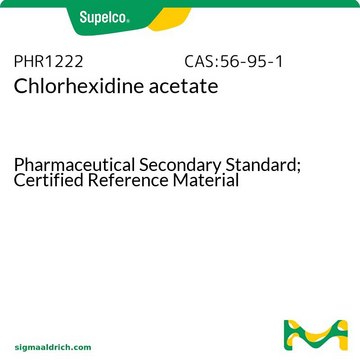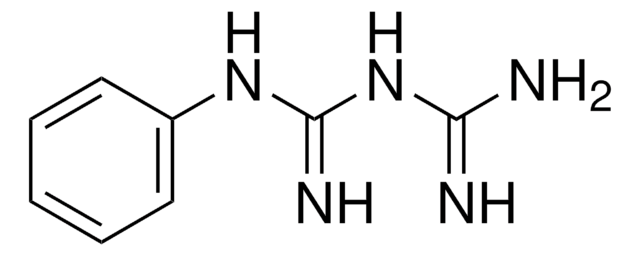Wichtige Dokumente
C6143
Chlorhexidine diacetate salt hydrate
bis(biguanide) antimicrobial
Synonym(e):
1,6-Bis(N5-[p-chlorophenyl]-N1-biguanido)hexane; 1,1′-Hexamethylenebis(5-[p-chlorophenyl]biguanide)
About This Item
Empfohlene Produkte
Qualitätsniveau
Form
powder
CMC
0.01% (25°C)(w/v)
Löslichkeit
ethanol: 50 mg/mL
Wirkungsspektrum von Antibiotika
Gram-negative bacteria
Gram-positive bacteria
Wirkungsweise
cell membrane | interferes
Lagertemp.
room temp
SMILES String
ClC1=CC=C(NC(NC(NCCCCCCNC(NC(NC2=CC=C(Cl)C=C2)=N)=N)=N)=N)C=C1.OC(C)=O.OC(C)=O
InChI
1S/C22H30Cl2N10.2C2H4O2/c23-15-5-9-17(10-6-15)31-21(27)33-19(25)29-13-3-1-2-4-14-30-20(26)34-22(28)32-18-11-7-16(24)8-12-18;2*1-2(3)4/h5-12H,1-4,13-14H2,(H5,25,27,29,31,33)(H5,26,28,30,32,34);2*1H3,(H,3,4)
InChIKey
WDRFFJWBUDTUCA-UHFFFAOYSA-N
Anwendung
Biochem./physiol. Wirkung
Sonstige Hinweise
Haftungsausschluss
Signalwort
Warning
H-Sätze
Gefahreneinstufungen
Acute Tox. 4 Oral - Aquatic Acute 1 - Aquatic Chronic 1 - Eye Irrit. 2 - Skin Irrit. 2 - STOT SE 2
Zielorgane
Liver,Teeth
Lagerklassenschlüssel
11 - Combustible Solids
WGK
WGK 3
Flammpunkt (°F)
Not applicable
Flammpunkt (°C)
Not applicable
Persönliche Schutzausrüstung
Eyeshields, Gloves, type N95 (US)
Hier finden Sie alle aktuellen Versionen:
Besitzen Sie dieses Produkt bereits?
In der Dokumentenbibliothek finden Sie die Dokumentation zu den Produkten, die Sie kürzlich erworben haben.
Kunden haben sich ebenfalls angesehen
Unser Team von Wissenschaftlern verfügt über Erfahrung in allen Forschungsbereichen einschließlich Life Science, Materialwissenschaften, chemischer Synthese, Chromatographie, Analytik und vielen mehr..
Setzen Sie sich mit dem technischen Dienst in Verbindung.











